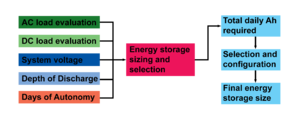Energy storage sizing and selection
The Energy storage system is sized based upon the average daily energy requirements for the system and several key parameters.
Step 1: Determine depth of discharge parameter
The depth of discharge parameter determines the percentage of the energy storage system that be considered usable for the system design. The depth of discharge (DoD) value chosen affects the capacity, cycle life, and cost of the energy storage system. Lead acid batteries are not tolerant of regular deep discharges, thus values between .4-.5 (40-50%) are typically used. A value of .5 is often cited as providing the highest number of cycles relative to cost, but there are additional considerations that should go into determing the Depth of discharge value:
- A system that is anticipated to be used heavily may warrant a more conservative value.
- A system that is in a difficult o access location may warrant a more conservative value.
Step 2: Determine days of autonomy paremeter
The days of autonomy parameter determines the number of days that the system will be able to meet energy needs without additional charging. 1 day of autonomy provides enough energy storage capacity to provide energy for the loads from the load evaluation without any additional charging. Each additional day adds an additional day of energy storage capacity. For example:
- 205 Ah lead acid battery system x 1 day of autonomy = 205 Ah
- 205 Ah lead acid battery x 2 days of autonomy = 410 Ah
- 205 Ah lead acid battery x 3 days of autonomy = 615 Ah
The value that is chosen for this parameter depends largely upon the variability of the solar resource, the intended use of the system, and the budget. It is almost always preferable to have additional storage, therefore budget often becomes the primary constraint. There are various considerations that go into determining the value that is appropriate for a particular design:
- If a system is intended for a location where the weather or solar resource is highly variable, the value for days of autonomy should be increased. It is possible using Weather and solar resource data sources to examine how frequently bouts of bad weather occur and their duration in any given location.
- If a system is intended to power at a location where the users can will adjust their energy consumption according to the weather or that is used infrequently, fewer days of autonomy can be built into the system and no additional generation is likely needed. A value of 1-2 days of autonomy may be appropriate in these cases as long as there is a sufficiently sized PV source.
- If a system is intended to provide power at a location that must operate continually, like at a health clinic, it is recommended that a significant number of days of autonomy are build into the system or that an additional form of generation, like a generator, is added to the system. An energy storage system with 5 days of autonomy for a health clinic will often be quite substantial in size, difficult to charge properly, and very costly. A backup generator should be considered in this case.
- The days of autonomy value that is chosen will be size the energy storage system to meet energy demand when the battery bank is new, but the storage capacity of the energy storage system will gradually decline over time. Therefore oversizing a battery bank to take this into account is a good idea.
Step 3: Calculate average daily Watt-hours requirement
| Average daily Watt-hours required | = Total average daily DC Watt-hours + Total average daily AC Watt-hours |
|---|
Step 4: Determine battery temperature correction factor The temperature of lead acid batteries has a significant effect upon performance. When lead acid batteries reach a temperature below 25°C, their usable capacity begins to decline. This can lead to batteries being deeply discharged and damaged, therefore the size of the energy storage system should be adjusted to ensure that there is adequate energy available at the minimum expected indoor temperature for the location. Correction factors for various battery types:[1]
| Temperature | FLA | AGM | Gel |
|---|---|---|---|
| 25°C | 1.00 | 1.00 | 1.00 |
| 10°C | 1.19 | 1.08 | 1.11 |
| 0°C | 1.39 | 1.20 | 1.25 |
| -10°C | 1.70 | 1.35 | 1.42 |
Step 5: Calculate average daily Ah required
| Average daily Ah required | = Average daily Watt-hours required (from Step 3) ÷ System voltage parameter × Battery temperature correction factor (Step 4) × Days of autonomy parameter (Step 2) ÷ Depth of discharge parameter (Step 1) |
|---|
Notes/references
- ↑ Trojan Battery Company - Battery Sizing Guidelines https://www.trojanbattery.com/pdf/TRJN0168_BattSizeGuideFL.pdf
